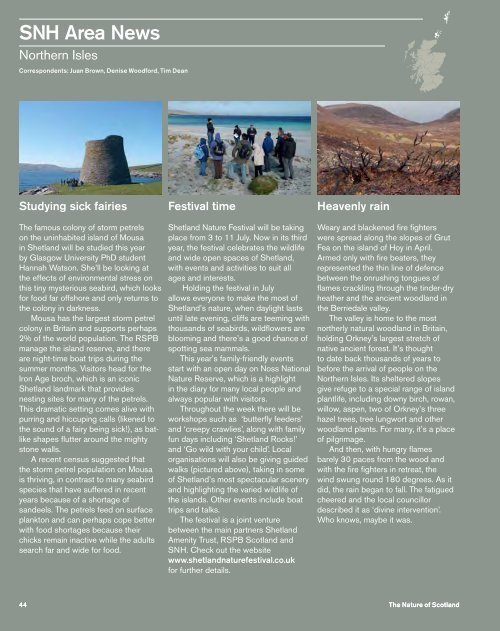Create successful ePaper yourself
Turn your PDF publications into a flip-book with our unique Google optimized e-Paper software.
SNH Area News<br />
Northern Isles<br />
Correspondents: Juan Brown, Denise Woodford, Tim Dean<br />
Studying sick fairies<br />
Festival time<br />
Heavenly rain<br />
<strong>The</strong> famous colony <strong>of</strong> storm petrels<br />
on the uninhabited island <strong>of</strong> Mousa<br />
in Shetland will be studied this year<br />
by Glasgow University PhD student<br />
Hannah Watson. She’ll be looking at<br />
the effects <strong>of</strong> environmental stress on<br />
this tiny mysterious seabird, which looks<br />
for food far <strong>of</strong>fshore and only returns to<br />
the colony in darkness.<br />
Mousa has the largest storm petrel<br />
colony in Britain and supports perhaps<br />
2% <strong>of</strong> the world population. <strong>The</strong> RSPB<br />
manage the island reserve, and there<br />
are night-time boat trips during the<br />
summer months. Visitors head for the<br />
Iron Age broch, which is an iconic<br />
Shetland landmark that provides<br />
nesting sites for many <strong>of</strong> the petrels.<br />
This dramatic setting comes alive with<br />
purring and hiccuping calls (likened to<br />
the sound <strong>of</strong> a fairy being sick!), as batlike<br />
shapes flutter around the mighty<br />
stone walls.<br />
A recent census suggested that<br />
the storm petrel population on Mousa<br />
is thriving, in contrast to many seabird<br />
species that have suffered in recent<br />
years because <strong>of</strong> a shortage <strong>of</strong><br />
sandeels. <strong>The</strong> petrels feed on surface<br />
plankton and can perhaps cope better<br />
with food shortages because their<br />
chicks remain inactive while the adults<br />
search far and wide for food.<br />
Shetland <strong>Nature</strong> Festival will be taking<br />
place from 3 to 11 July. Now in its third<br />
year, the festival celebrates the wildlife<br />
and wide open spaces <strong>of</strong> Shetland,<br />
with events and activities to suit all<br />
ages and interests.<br />
Holding the festival in July<br />
allows everyone to make the most <strong>of</strong><br />
Shetland’s nature, when daylight lasts<br />
until late evening, cliffs are teeming with<br />
thousands <strong>of</strong> seabirds, wildflowers are<br />
blooming and there’s a good chance <strong>of</strong><br />
spotting sea mammals.<br />
This year’s family-friendly events<br />
start with an open day on Noss National<br />
<strong>Nature</strong> Reserve, which is a highlight<br />
in the diary for many local people and<br />
always popular with visitors.<br />
Throughout the week there will be<br />
workshops such as ‘butterfly feeders’<br />
and ‘creepy crawlies’, along with family<br />
fun days including ‘Shetland Rocks!’<br />
and ‘Go wild with your child’. Local<br />
organisations will also be giving guided<br />
walks (pictured above), taking in some<br />
<strong>of</strong> Shetland’s most spectacular scenery<br />
and highlighting the varied wildlife <strong>of</strong><br />
the islands. Other events include boat<br />
trips and talks.<br />
<strong>The</strong> festival is a joint venture<br />
between the main partners Shetland<br />
Amenity Trust, RSPB <strong>Scotland</strong> and<br />
SNH. Check out the website<br />
www.shetlandnaturefestival.co.uk<br />
for further details.<br />
Weary and blackened fire fighters<br />
were spread along the slopes <strong>of</strong> Grut<br />
Fea on the island <strong>of</strong> Hoy in April.<br />
Armed only with fire beaters, they<br />
represented the thin line <strong>of</strong> defence<br />
between the onrushing tongues <strong>of</strong><br />
flames crackling through the tinder-dry<br />
heather and the ancient woodland in<br />
the Berriedale valley.<br />
<strong>The</strong> valley is home to the most<br />
northerly natural woodland in Britain,<br />
holding Orkney’s largest stretch <strong>of</strong><br />
native ancient forest. It’s thought<br />
to date back thousands <strong>of</strong> years to<br />
before the arrival <strong>of</strong> people on the<br />
Northern Isles. Its sheltered slopes<br />
give refuge to a special range <strong>of</strong> island<br />
plantlife, including downy birch, rowan,<br />
willow, aspen, two <strong>of</strong> Orkney’s three<br />
hazel trees, tree lungwort and other<br />
woodland plants. For many, it’s a place<br />
<strong>of</strong> pilgrimage.<br />
And then, with hungry flames<br />
barely 30 paces from the wood and<br />
with the fire fighters in retreat, the<br />
wind swung round 180 degrees. As it<br />
did, the rain began to fall. <strong>The</strong> fatigued<br />
cheered and the local councillor<br />
described it as ‘divine intervention’.<br />
Who knows, maybe it was.<br />
44 <strong>The</strong> <strong>Nature</strong> <strong>of</strong> <strong>Scotland</strong>

















